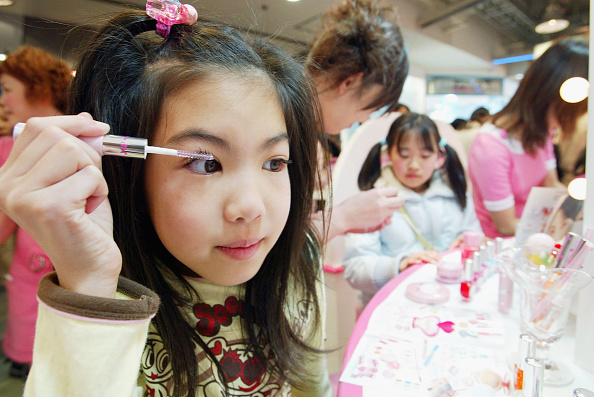
A few weeks ago, I saw my two nephews. My mum keeps a big box of our old toys, and the three-year-old loves the kitchen set: he delights in plonking radioactive-looking broccoli florets on plates or, learning from trips to Starbucks with his mum, making me “mint teas” in empty paper cups. It brought back memories of my twin sister and I playing house — coddling our existentially staring Baby Annabells, cooking up imaginary banquets and sassily roleplaying with fake flip phones. Is there anything so harmless?
But recently, make-believe has had a facelift. Gen Alpha — aged around 13 and under — have grown up to the sound of pinging iPhones. The effects of omnipresent social media have yet to appear in their entirety, but recent studies have reported, aghast, that among other things young children now “swipe” books instead of turning the pages. What is less discussed is the fate of that narrow window between girlhood and womanhood, where imitation — of our mothers, sisters, TV idols — informs the adults we become.
Enter the tween skincare addicts: girls as young as 10 slathering excoriating retinoids on their baby faces, scanning beauty aisles for hyaluronic acid formulas, bookmarking videos of the best “dupes” of £300 La Mer moisturisers. These girls are copying women who are, in turn, trying to prevent the ravages of age. It’s a closed circuit with one clear beneficiary: skincare companies such as Drunk Elephant which, TikTok detectives speculate, uses bright packaging to deliberately entice the youngest potential customers.
So-called “Sephora kids” have become a new virtual bogeyman, with videos of throngs of tweens queuing up at the beauty department store raking in thousands of likes and indignant comments. Viewers complain of children leaving samples spilling over counters, dragging parents to tills to drop a week’s wages on It-products, or slapping on lotions with the exuberance of a rebellious daughter digging through her mum’s makeup bag. For this is exactly what it is: ancient bottles of Estée Lauder Double Wear and dusty Bobbi Brown blushes found during tip-toeing trips to your mum’s bedroom have simply been replaced with slick, silicon-free Bubble and Glossier cleansers name-checked in online beauty “hauls”. Tweens have always roleplayed as the adults they see — the difference, now, is that these are strangers online espousing the rites of a new purification cult.
In the glossed, plucked and pouty world of TikTok, anything and everything can be improved, filtered and fixed. A decade ago, when millennials began deploying filters and Facetune, photos of pub crawls and freshers weeks gave way to selfies with lolling dog tongues and colossal lashes. Gradually, women began to self-fashion to resemble these filters: they would paint on, or inject in, a Kardashian cheekbone, a Jolie lip or the Tipp-ex white teeth of a Love Islander.
But Gen Z has bucked the trend to embrace “wellness”, with its fixation on “natural” looks and lifestyles in such a way that medication, meditation and skincare have turned the scrutiny inwards. Balking at the artifice of noughties glamour, with its visible extensions, orange foundation and boob jobs, Gen Z has moved towards an extremely effortful effortlessness in the form of the minimalistic “clean girl aesthetic”. The clean girl sweeps her hair into a claw clip French twist. She has a clear complexion perfected with an arsenal of skincare solutions, and if she wears foundation it must be so light as to be virtually undetectable. She is always flushed, probably having just come in from a “hot girl walk” to fetch a matcha latte. And she can probably be found journalling, manifesting, setting relationship boundaries or drinking CBD-infused kombucha.
The look has been accused of being fatphobic, classist, ageist and racist. But what is less discussed is its focus on ritual: “clean girl” skincare regimes are not simply a lifestyle trend but a purification rite to distinguish apostles from the silicone-filled, lush-lashed “dirty girls” who are not, never, like us. The trend’s implicit snobbery attempts to rein in bodily mess and discomfort — after all, the overriding sensations of girlhood — and to erase any trace of effort. It completes the horrific logic of beauty: I am the standard, and look — I didn’t even have to try. With such an obsession with prevention, of ageing, ugliness and, above all, unwellness, did Gen Alpha ever stand a chance?
Millennial columnists have long lamented the “puriteen“: the Gen Z archetypes who swerve drink, drugs, sex and debate for wellness, regimen and homogenous “wokeness”. As a Gen Z, I think this characterisation is mostly exaggerated — a classic of the “in my day” genre. But online, within a few hours of liking the right videos, you could very quickly be led by algorithms to believe that not a single person under 25 has ever shagged, shouted or spewed. As a generation, we seem extremely put-together — and it is this facade that children and tweens are copying. Brace-faced girls lining up to spend their pocket money on premium skincare products are mimicking the performativity of their older sisters who, after long shifts “getting ready with me” on TikTok live, settle down to nights of bed-rotting, doom-scrolling and goblin-mode catatonia.
We Gen Zs know wellness is just another fantasy — but as long as influencers play pretend, tweens will pretend back. There is a danger that Gen Alpha — who are destined to grow up with exceptional internet-forged cynicism but are too young to have yet mastered this — will take my generation’s puritanical tendencies at face value, seeing them as essential and, dare I say it, cool parts of femininity. It is clear to anyone who watches a nine-year-old talk to camera about the lathering power of a cleanser that they are, quite simply, taking it all way too seriously.
And yet the awkward, gawky grossness of being an adolescent girl is incredibly important. I spent a memorable summer before starting secondary school hunching around in patchwork linen tunics with white, lace-trimmed leggings, looking like something out of an avant-garde retelling of Oliver Twist. If that seems impossible to visualise, all the better.
I didn’t get social media — specifically, Facebook — until I was 19; at the time I’d mumble something about it not “aligning with my principles” when in reality, I was self-conscious and self-aware enough to know that no digital footprint should exist of the painfully uncool strangeness of my girlhood. Although my lameness was probably exceptional, I am now so glad of this foresight: adolescence, a delicate and desperate thing, is made of private fantasies and bodily weirdness. When exposed to the disinfectant sunlight of social media, how can young girls expect to develop any sort of “authenticity” — which is, after all, social media’s holy grail? Might these children, with every squirt of their Bubble Bounce Back Balancing Toner Mist, be aligning themselves with visions of womanhood which sterilise reality and originality?
What happens when the specific oddness of this time is combined with the purification rituals of women in their twenties and thirties? Jonathan Haidt, in his latest book, has written of the displacement of “play-based childhood” with a “phone-based” version by the early 2010s; one result of this is that today’s teens, already beset by mental health problems and doomed to an extended adolescence by our dire economy, are expecting to emerge perfect from prepubescence as miniature 30-year-olds.
So yes, little girls playing dress-up with luxury skincare products, while expensive and pointless, is not the end of the world. But the compulsion to do chemical peels when you haven’t even started your period might kill that tender, excruciating unknowingness of being somewhere in between little and big, an age at which only the bedroom mirror should bear witness to the way girls love and lament their changing faces.









